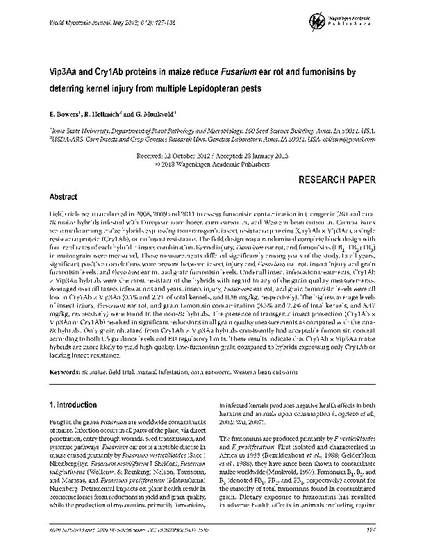
Field trials were conducted in 2008, 2009 and 2011 to assess fumonisin contamination in transgenic Bacillus thuringiensis (Bt) and non-Bt maize hybrids infested with European corn borer, corn earworm, and Western bean cutworm. Comparisons were made among maize hybrids expressing two transgenic insect resistance proteins (Cry1Ab x Vip3Aa), a single resistance protein (Cry1Ab), or no insect resistance. The field design was a randomized complete block with four replicates of each hybrid x insect combination. Kernel injury, Fusarium ear rot, and fumonisins (FB1+FB2+FB3) in maize grain were measured. These measurements differed significantly among years of the study. In all years, significant positive correlations were present between insect injury and Fusarium ear rot, insect injury and grain fumonisin levels, and Fusarium ear rot and grain fumonisin levels. Under all insect infestation treatments, Cry1Ab x Vip3Aa hybrids were the most resistant of the hybrids with regard to any of the grain quality measurements. Averaged over all insect infestations and years, insect injury, Fusarium ear rot, and grain fumonisin levels were all low in Cry1Ab x Vip3Aa (0.1% and 2.2% of total kernels, and 0.56 mg/kg, respectively). The highest average levels of insect injury, Fusarium ear rot, and grain fumonisin contamination (3.3% and 7.2% of total kernels, and 5.47 mg/kg, respectively) were found in the non-Bt hybrids. The presence of transgenic insect protection (Cry1Ab x Vip3Aa or Cry1Ab) resulted in significant reductions in all grain quality measurements as compared with the non-Bt hybrids. Only grain obtained from Cry1Ab x Vip3Aa hybrids consistently had acceptable fumonisin content according to both U.S. guidance levels and E.U. regulatory limits. These results indicate that Cry1Ab x Vip3Aa maize hybrids are more likely to yield high quality, low-fumonisin grain compared to hybrids expressing only Cry1Ab or lacking insect resistance.
Available at: http://works.bepress.com/gary_munkvold/28/

This research paper is from World Mycotoxin Journal 6 (2013): 127.